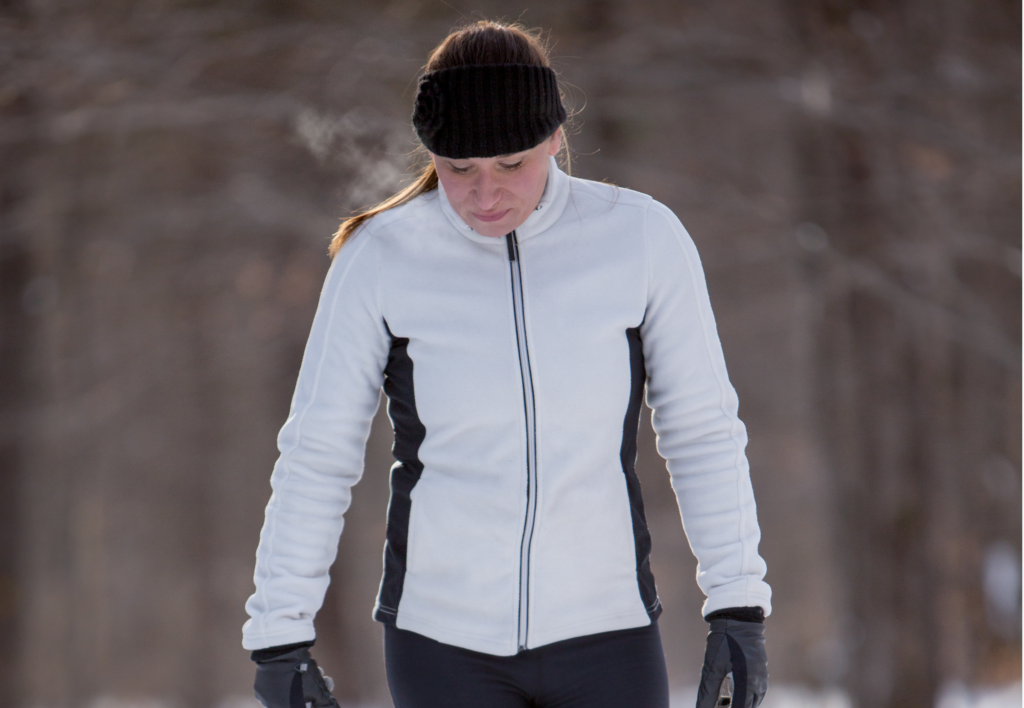5 Breathing Techniques to Master for Cold-Weather Running!
Cold-weather running can be invigorating, but it requires special attention to detail, especially when it comes to breathing. Unlike the warmer months, where the air is easier to inhale, cold air can be harsh and dry, making it difficult for your lungs to process. This can lead to a tight chest, wheezing, or even exercise-induced bronchoconstriction (EIB), which affects an estimated 10-20% of elite athletes.
Mastering the right breathing techniques is not just about comfort; it’s about optimizing your performance and ensuring your safety while running in the cold.
In this post, we’ll explore five breathing techniques that can help you maintain your running regimen throughout the winter months, ensuring that you’re getting the oxygen you need while protecting your respiratory system.
1. Diaphragmatic Breathing
Diaphragmatic breathing, often referred to as “belly breathing,” is a technique that encourages full oxygen exchange and can be particularly beneficial for runners braving the cold.
By engaging the diaphragm more effectively, you can increase your oxygen intake and reduce the workload on your neck and chest muscles, which can become tense in cold weather.
Here’s how to practice diaphragmatic breathing:
- Find a comfortable position: Start by lying down on your back with your knees slightly bent, or sit up straight in a chair.
- Place your hands: Put one hand on your upper chest and the other just below your rib cage. This will allow you to feel your diaphragm move as you breathe.
- Inhale slowly: Breathe in slowly through your nose, ensuring that your stomach moves out against your hand. The hand on your chest should remain as still as possible.
- Exhale with purpose: Tighten your abdominal muscles and let them fall inward as you exhale through pursed lips. The hand on your chest should continue to remain still.
Incorporating diaphragmatic breathing into your running routine can help you maintain a steady rhythm and avoid the short, shallow breaths that often accompany cold-weather exertion.
A study published in the Journal of Physical Therapy Science found that diaphragmatic breathing exercises can improve pulmonary function and abdominal muscle activity, which is crucial for runners looking to maintain endurance and stability in the face of chilly conditions (Journal of Physical Therapy Science).

2. Nasal Breathing
One of the most effective ways to combat the sting of cold air in your lungs is through nasal breathing. This technique involves taking breaths exclusively through your nose, which allows the air to be warmed and humidified before reaching your lungs.
Nasal breathing also helps filter out impurities and foreign particles, which is particularly beneficial in urban environments where air quality may be compromised.
Here are some practical tips for mastering nasal breathing during your runs:
- Start slow: If you’re not used to nasal breathing, begin by practicing during your warm-up or cool-down. Once you’re comfortable, gradually increase the time you use this method during your actual run.
- Focus on form: Keep your mouth closed and jaw relaxed. Breathe in slowly through your nose, and try to fill your lungs from the bottom up, just as you do with diaphragmatic breathing.
- Use it as a tool for pacing: Nasal breathing can help you maintain a moderate pace, as it naturally limits the amount of air you can take in. Use this to your advantage to avoid starting out too fast in cold weather, which can lead to quicker fatigue.
- Incorporate it into interval training: During your slower intervals or recovery periods, switch back to nasal breathing to help control your heart rate and recovery.
The benefits of nasal breathing are not just anecdotal; research has shown that it can reduce the risk of respiratory problems such as EIB in cold weather.
A study in the Journal of Human Kinetics found that nasal breathing reduces the amount of cold air that reaches the lower airways, which can help minimize the risk of bronchoconstriction (Journal of Human Kinetics).

3. Rhythmic Breathing
Rhythmic breathing, also known as cadence breathing, is a method that involves syncing your breaths with your footsteps.
This technique can help you create a steady respiratory pattern that complements the rhythm of your run, which is particularly useful in cold weather when breathing can become more labored.
To practice rhythmic breathing, follow these steps:
- Find your cadence: Start by counting the number of steps you take for each inhale and exhale. A common pattern is a 3:3 ratio, where you inhale for three steps and exhale for three steps, but you can adjust this based on your pace and comfort level.
- Experiment with ratios: Depending on your running speed and lung capacity, you may find that a 2:2, 3:2, or 4:3 ratio works better for you. The key is to find a pattern that feels sustainable and comfortable.
- Focus on even distribution: Make sure you’re not favoring one side of your body as you breathe. This can lead to imbalances and even side stitches. Try to alternate the foot you land on when you start each inhale and exhale.
- Use rhythmic breathing for focus: This technique can also serve as a form of meditation, helping you focus on your run and maintain a mindful state, which is especially helpful in the solitude of cold weather runs.
The science behind rhythmic breathing is solid; it can help improve running efficiency and reduce the risk of injury.
A study published in the Journal of Sports Science & Medicine suggests that synchronizing breathing with running stride reduces the impact stress of running, which can be particularly beneficial when dealing with the hard, unforgiving surfaces of winter roads (Journal of Sports Science & Medicine).

4. Pursed-Lip Breathing
When the winter winds blow, runners may find their breath becomes short and labored. Pursed-lip breathing is a simple yet effective exercise that can help control your breathing pace and make your cold-weather runs more manageable.
What is Pursed-Lip Breathing?
Pursed-lip breathing is a technique that involves breathing in through the nose and exhaling through lips that are almost closed, as if you’re about to whistle. This method prolongs exhalation and can prevent the rapid, shallow breaths that often accompany exertion in cold temperatures.
How to Practice Pursed-Lip Breathing:
- Inhale Slowly: Begin by inhaling slowly and deeply through your nose for about two seconds. Imagine you’re filling your lungs from the bottom up.
- Purse Your Lips: Pucker your lips as though you’re preparing to blow out candles on a birthday cake.
- Exhale Gently: Breathe out slowly through your pursed lips for approximately four seconds. The extended exhalation helps to release more air from the lungs and keeps the airways open longer.
- Repeat: Continue this breathing pattern for a few minutes, gradually implementing it during your runs, especially when you need to regain control of your breath.
The benefits of pursed-lip breathing go beyond the immediate relief of breathlessness.
A study published in the Journal of Cardiopulmonary Rehabilitation and Prevention showed that this technique could improve exercise capacity and alleviate symptoms of dyspnea in people with respiratory issues, making it a valuable tool for runners facing the harshness of cold air (Journal of Cardiopulmonary Rehabilitation and Prevention).
5. Coordinated Breathing
Coordinated breathing is another technique that can be particularly useful for runners looking to improve their breathing control. This exercise not only helps in establishing a rhythm for your breaths but also enhances the coordination between your respiratory and muscular systems.
What is Coordinated Breathing? This technique involves syncing your breath with your movements, promoting a harmonious flow that can improve lung function and running form.
How to Practice Coordinated Breathing:
- Find Your Position: Stand or sit in a relaxed position. Ensure that your posture allows for full lung expansion.
- Sync Breath with Movement: As you inhale, step forward with one foot and simultaneously raise both arms overhead. This encourages maximum lung inflation.
- Exhale with Motion: As you exhale, bring your arms back down and step back to the original position. This movement helps to expel the air from your lungs.
- Alternate and Repeat: Continue this process, alternating feet with each cycle, for several minutes. As you become more comfortable, try to implement this coordinated breathing while walking, and eventually during your running warm-up or cool-down.
Incorporating coordinated breathing into your running routine can have a significant impact on your respiratory efficiency. By practicing this technique, you can help strengthen the diaphragm and intercostal muscles, which play a crucial role in breathing, particularly during physical exertion.

Bonus Tip – Wear a Mask or Scarf
Another practical tip for cold-weather running is to cover your mouth and nose with a scarf or mask. This can create a microclimate that warms and humidifies the air before you breathe it in, reducing the shock of cold air on your respiratory system.
Here are some considerations when choosing to cover your face during a run:
- Material: Look for a scarf or mask made from moisture-wicking material to prevent dampness and maintain warmth. Avoid cotton, as it can retain moisture and potentially make you feel colder.
- Fit: Ensure the mask or scarf fits snugly but comfortably around your face without slipping. It should allow for easy breathing without any significant restriction.
- Adjustment Period: Give yourself time to adjust to the sensation of running with your face covered. Start by wearing it for short periods during your run and gradually increase as you become more comfortable.
- Hygiene: If you’re using a mask or scarf repeatedly, make sure to wash it regularly to maintain cleanliness and prevent the buildup of bacteria.
While there isn’t extensive research on the benefits of wearing a mask specifically for cold-weather running, studies have shown that pre-warming the air can mitigate symptoms of asthma triggered by exercise in cold environments (European Respiratory Journal).
By warming the air before it enters your lungs, you can make your cold-weather runs more comfortable and reduce the risk of respiratory distress.
Conclusion
Running in cold weather can be a refreshing and rewarding experience, but it also requires a thoughtful approach to breathing. By mastering the breathing techniques and exercises we’ve discussed, you can enhance your performance, protect your respiratory health, and enjoy the crisp winter air without discomfort.
To recap, we’ve explored the benefits of diaphragmatic breathing for engaging the full capacity of your lungs, the advantages of nasal breathing for warming and filtering the air, and the efficiency of rhythmic breathing for maintaining a steady pace. We’ve also highlighted breathing exercises like pursed-lip breathing and coordinated breathing to improve lung function and control. Lastly, we discussed the importance of wearing a mask or scarf to warm and humidify the air before it enters your lungs.
As you lace up your running shoes and head out into the cold, remember to start slow with these techniques and give yourself time to adapt. It’s important to listen to your body and make adjustments as needed. With practice, these breathing strategies will become second nature, and you’ll find yourself running more comfortably and effectively, no matter how low the temperatures drop.
Whether you’re a seasoned winter runner or just starting to brave the chill, integrating these breathing techniques into your routine can make a significant difference. So take a deep, warm breath and embrace the cold — your winter runs await!






